Viva Resa: Your Gateway to Insightful Living
Discover news, trends, and tips for a vibrant lifestyle.
Manga Madness: Why You Should Be Reading Beyond the Screen
Dive into the world of Manga Madness and discover why the pages hold secrets and stories that screens can't capture! Read now!
Top 5 Reasons Manga Beats Anime: Discover the Depth of Storytelling
Manga often reigns supreme over its animated counterparts due to the profound depth of storytelling it offers. One of the primary reasons is the intricate character development that manga provides. Unlike anime, which is often constrained by episode limits and runtime, manga allows authors to explore thoughts, backgrounds, and motivations in greater detail. This comprehensive character focus creates a more immersive experience, giving readers a deeper understanding of the characters' journeys and decisions.
Furthermore, the pacing of manga contributes significantly to its narrative strength. While anime can be subject to filler episodes and rushed arcs in order to adhere to broadcasting schedules, manga provides a steady pace that allows for thorough world-building and plot exploration. Readers can luxuriate in every panel, absorbing the nuances of the story without the pressure of time constraints. This unhurried approach is a key factor in why many fans believe that manga beats anime in terms of storytelling depth.

Manga vs. Anime: What Are You Missing By Only Watching?
Manga and anime are two distinct yet interconnected forms of storytelling that have captivated audiences worldwide. While anime adaptations bring vibrant visuals and dynamic sound to beloved series, there's a wealth of narrative depth and character development often found only within the pages of manga. By solely watching anime, you miss out on the intricate details, subplots, and character nuances that the original manga conveys. For instance, certain arcs may be shortened or omitted entirely in anime adaptations for time constraints, leaving viewers with an incomplete understanding of the story's emotional and thematic richness.
Moreover, many manga series delve into the inner thoughts and feelings of characters that are not always effectively translated to the screen. The pacing in manga allows for a more immersive experience, letting readers absorb every moment at their own speed. By exclusively watching anime, you might overlook the artist's unique style and storytelling techniques that contribute to the overall experience. Ultimately, embracing both formats can enhance your appreciation of the artistry involved, offering a more comprehensive understanding of your favorite stories and characters.
The Evolution of Manga: How Storytelling Has Shaped Popular Culture
The evolution of Manga has been remarkable, transforming from simple illustrated stories to a multifaceted medium that intertwines art and narrative. Originating in Japan, Manga encompasses a variety of genres and styles, catering to diverse audiences. Over the years, the storytelling techniques used in Manga have significantly influenced other forms of media, including anime, films, and even video games. The character development and intricate plots found in modern Manga serve as a blueprint for successful storytelling across popular culture, showcasing a deep connection between narrative and audience engagement.
As Manga continues to evolve, it has become a cultural phenomenon that transcends geographical boundaries. With the rise of digital platforms, international readers can now enjoy Manga in various languages, further promoting its widespread appeal. This accessibility has led to increased demand for Manga, thereby inspiring global franchises and collaborations that blend traditional storytelling with contemporary themes. The fusion of styles and influences in the Manga industry illustrates its pivotal role in shaping modern popular culture, making it a dynamic force that continues to redefine artistic expression and narrative innovation.